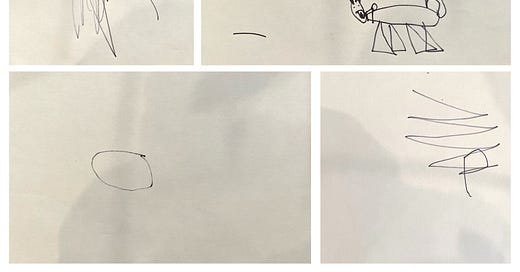Two days ago, I said to my daughter, “How do you come up with so many creative, beautiful pictures?!”
“Because I’m a very good artist,” she said, matter-of-fact. At the time I thought: That’s what I should write about in my next Dispatch. Self-belief, confidence, assertion of your artist’s identity, all that jazz.
Fast-forward to today. I sat on the deck writing while this same self-declared artist set out to copy a watercolor painting I’d made of our dogs. Not one minute after getting settled, she came growling and tearing outside. “I HATE THEM! THEY ARE TERRIBLE!” she wailed. She thrust two failed iterations at me, white paper with harsh black scribbles across them.
Ah yes, I thought. This is more like it.
If you’re a creative of some sort, I’m guessing you can relate.
Charlie asked if I could draw the fence for her. She showed me her own attempts, explained that hers didn’t have enough details, said she couldn’t get it right.
I said to keep trying. I suggested that she practice on a separate piece of paper first. She tried this but returned to me moments later and groused that she still couldn’t get it right, she couldn’t get any of it right! I said to keep trying.
She reminded me that I had said not to waste paper (I had indeed said that, when we first sat down and she made a single mark on a page, then decided to start over). So I grabbed a stack of clean white pages and told her to have at it.
Below, a sampling of her discarded efforts:
There were more tears, more frustrated declarations. I’m not gonna lie—this story ends with me drawing the fence for her. But along the way, we had a conversation that applies to any artist, at any stage and in any medium.
We talked about:
Embracing mistakes and turning them into something new.
Drawing (or writing or creating) something a hundred times before you feel like you got it right.
Learning to love your own unique style—not always trying to emulate someone else.
Looking back at something you created and noticing a thousand small details you aren’t happy with, while someone else might look at the same piece and think it’s perfect.
Breaking something big into smaller pieces to feel less overwhelmed.
Her finished product (yes, with a bit of help from me to draw the shapes):
One morning recently I texted my partner to complain about the difficult story I was trying to rework, how I couldn’t get it right.
Near the end of the day, I sent him an update he hadn’t asked for: after returning to the piece with fresh eyes, I had found myself a breakthrough.
And the truth is there wasn’t any trick to it. What I had to do was keep circling back, keep chewing on it, keep showing up to the problem and the story. I rewrote two or three brief sentences probably dozens of times. The longer I kept at it, the more those sentences opened up for me. They made room.
It will take time for my six-year-old to learn this lesson.
She will someday internalize the discipline required for a fulfilling creative practice. But I can already see in her the contentment that comes when you finish something you feel you can be proud of. I can see the familiar journey from reckless self-assurance to despairing insecurity to quiet satisfaction.
Yesterday I picked up Rilke’s Letters to a Young Poet, and on the first page I highlighted something not from one of the letters but from the translator’s note: an observation that Rilke’s spirit might have been “speaking out of its own need”—that his words of comfort and wisdom were aimed just as much at himself as at the letters’ recipient.
This is probably also true of my ongoing conversations with the young artist who is my daughter. I remind her to be patient and kind with herself, and in doing so I remind myself the same thing.
May we all treat ourselves with the generosity we offer to younger creatives.
May we all recognize the youngness of our own spirits, the truth that we never really graduate from novice.






